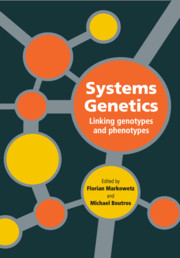Book contents
- Frontmatter
- Contents
- List of contributors
- 1 An introduction to systems genetics
- 2 Computational paradigms for analyzing genetic interaction networks
- 3 Mapping genetic interactions across many phenotypes in metazoan cells
- 4 Genetic interactions and network reliability
- 5 Synthetic lethality and chemoresistance in cancer
- 6 Joining the dots: network analysis of gene perturbation data
- 7 High-content screening in infectious diseases: new drugs against bugs
- 8 Inferring genetic architecture from systems genetics studies
- 9 Bayesian inference for model selection: an application to aberrant signalling pathways in chronic myeloid leukaemia
- 10 Dynamic network models of protein complexes
- 11 Phenotype state spaces and strategies for exploring them
- 12 Automated behavioural fingerprinting of Caenorhabditis elegans mutants
- Index
- Plate Section
- References
6 - Joining the dots: network analysis of gene perturbation data
Published online by Cambridge University Press: 05 July 2015
- Frontmatter
- Contents
- List of contributors
- 1 An introduction to systems genetics
- 2 Computational paradigms for analyzing genetic interaction networks
- 3 Mapping genetic interactions across many phenotypes in metazoan cells
- 4 Genetic interactions and network reliability
- 5 Synthetic lethality and chemoresistance in cancer
- 6 Joining the dots: network analysis of gene perturbation data
- 7 High-content screening in infectious diseases: new drugs against bugs
- 8 Inferring genetic architecture from systems genetics studies
- 9 Bayesian inference for model selection: an application to aberrant signalling pathways in chronic myeloid leukaemia
- 10 Dynamic network models of protein complexes
- 11 Phenotype state spaces and strategies for exploring them
- 12 Automated behavioural fingerprinting of Caenorhabditis elegans mutants
- Index
- Plate Section
- References
Summary
How to link genotypes and phenotypes is a long-standing question in modern biology. Modern high-throughput approaches are key technologies at the forefront of genetic research. They enable the analysis of a biological response to thousands of experimental perturbations and require a tight collaboration between experimental and computational scientists. Perturbation studies and computational approaches have revolutionized research in functional genomics and genetics and promise to lay the foundation for personalized medicine. For modern high-throughput technologies, computation is as important as experimentation. Genome-wide image-based RNA interference (RNAi) screens, for example, are only feasible because of computational techniques. Computational skills to analyse the data have become as important as experimental skills to generate the data.
Design and analysis of phenol typing screens depend on the number of genes perturbed and the richness of the phenotype observed (Figure 6.1). At one extreme are high-throughput screens with single reporters, e.g. a genome-wide screen for new components of a pathway. At the other extreme are perturbations of individual genes with very rich phenotypes, e.g. assessing the effects of a single gene perturbation on several molecular levels over time. Between these two extremes lie a variety of possible screen designs. Two widely used scenarios are small-scale perturbations (<20 genes) of a single target pathway with rich readouts, e.g. a global transcriptional profile, and medium-scale perturbations (hundreds of genes) with multi-parametric readouts, e.g. cell morphology or growth in different media. In the following we will discuss statistical and computational methodologies for functional analysis in all four scenarios.
Scenario 1: Genome-wide screens with single reporters
RNAi screens have been frequently and successfully applied for functional profiling of genes on a large scale (Boutros & Ahringer 2008). The vast majority of these applications use a single phenotype (e.g. cell viability, growth rate, activity of reporter constructs) to characterize the function of genes in specific biological pathways.
- Type
- Chapter
- Information
- Systems GeneticsLinking Genotypes and Phenotypes, pp. 83 - 107Publisher: Cambridge University PressPrint publication year: 2015

